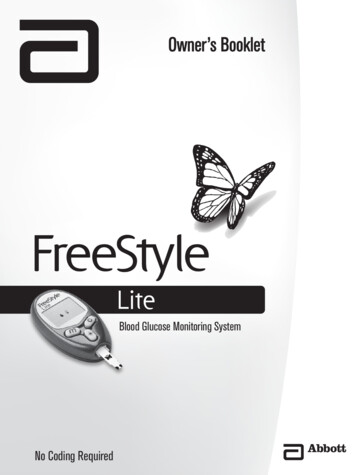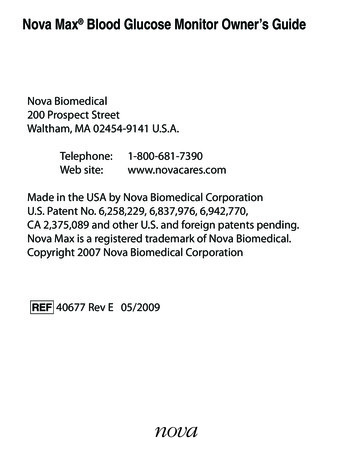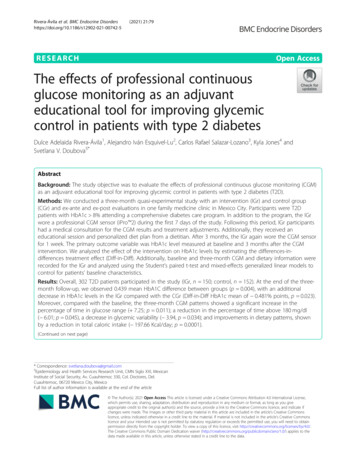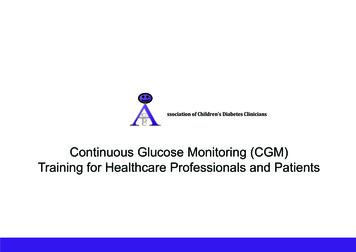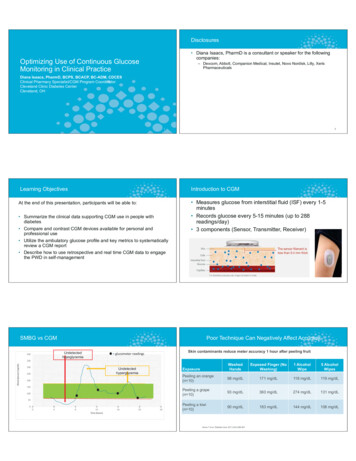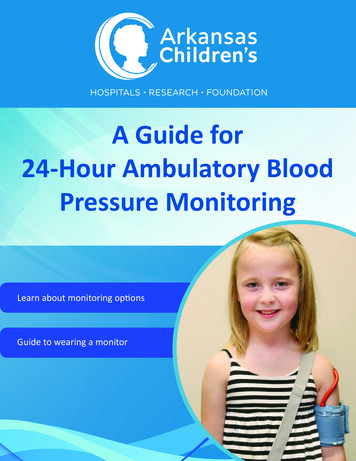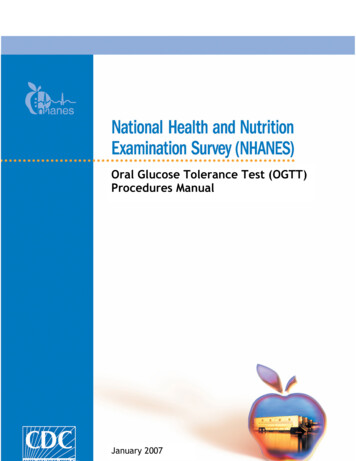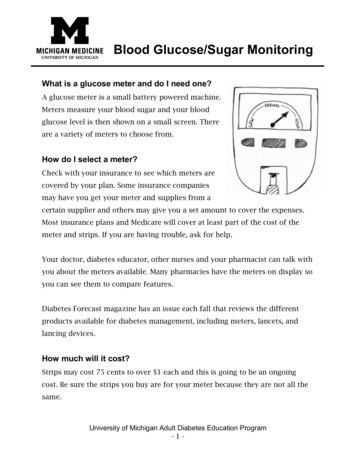
Transcription
Blood Glucose/Sugar MonitoringWhat is a glucose meter and do I need one?A glucose meter is a small battery powered machine.Meters measure your blood sugar and your bloodglucose level is then shown on a small screen. Thereare a variety of meters to choose from.How do I select a meter?Check with your insurance to see which meters arecovered by your plan. Some insurance companiesmay have you get your meter and supplies from acertain supplier and others may give you a set amount to cover the expenses.Most insurance plans and Medicare will cover at least part of the cost of themeter and strips. If you are having trouble, ask for help.Your doctor, diabetes educator, other nurses and your pharmacist can talk withyou about the meters available. Many pharmacies have the meters on display soyou can see them to compare features.Diabetes Forecast magazine has an issue each fall that reviews the differentproducts available for diabetes management, including meters, lancets, andlancing devices.How much will it cost?Strips may cost 75 cents to over 1 each and this is going to be an ongoingcost. Be sure the strips you buy are for your meter because they are not all thesame.University of Michigan Adult Diabetes Education Program-1-
What supplies do I need? Glucose test strips Lancets Glucose meter Lancing deviceWhat are lancets?The lancets are the needles used to stick your skin toget the drop of blood for testing.What is a lancing device?A lancing device holds the lancet and gives you acontrolled stick to reduce pain and prevent skindamage. Most devices let you adjust the depth of thepoke.Do test strips expire?Yes, each bottle will have an expiration date. Never use strips if the date hasexpired. Check product insert for details.How do I store my test strips?Make sure the cap fits snugly on the glucose strip bottle. Sunlight and moisturecan damage the strips. Store at room temperature in a dry place.What is coding?Some meters require “coding”. If so, you will find the code with each new bottleof test strips.University of Michigan Adult Diabetes Education ProgramBlood Glucose/Sugar Monitoring-2-
What is control solution?This is a special liquid to test if your meter is working properly. The liquidreacts with the chemicals in the strip to give a reading. Your test strips willhave a range marked on the bottle or on a paper in the box. If the reading fallsin the range, the machine is working correctly. The control solution oftenexpires several months after it has been opened.Where can I get a drop of blood?You can get a drop of blood from: The side(s) of your fingers / thumbs and palm of your hand. Your earlobe. Forearms or top of legs can be used with alternate sitemeters, but should not be used when blood sugar ischanging quickly or if you think you are having a low bloodsugar (BG). Most people use their fingers.What problems might happen with glucose testing?Sore fingers Use only the sides of the fingers or thumbs. Always use a lancing device. Use a different finger or thumb for each test. Lightly place the lancing device against the side of your finger. Consider alternate site testing. Adjust the depth on the lancing device.University of Michigan Adult Diabetes Education ProgramBlood Glucose/Sugar Monitoring-3-
Blood drop too small Shake your hand and lower it below heart level before lancing your finger. Do not use lancets without a lancing device. Adjust the depth on the lancing device. Wash your hands with warm, soapy water before testing. Squeeze / milk your finger until it turns pink before using the lancingdevice. Squeeze your finger after using the lancing device to get a bigger drop ofblood.What is on your hands? Hand sanitizer (like Purell) or other things on your hands can affect thereading. Make sure your hands are clean and dry before checking your bloodsugar.When should I test?When to check your blood sugar depends on your situation and what medicineyou take to manage your diabetes.You and your doctor will figure out the most useful times to check your bloodsugar depending on your medicine, daily life and insurance.Blood sugar goals vary from person to person depending on many things, soit’s a good idea to check with your doctor to find out what your personal goalwill be. Here are the target ranges from the American Diabetes Association:FastingBefore Meals2 Hours after Meals80-120 mg/dL80-140 mg/dLLess than 180 mg/dLUniversity of Michigan Adult Diabetes Education ProgramBlood Glucose/Sugar Monitoring-4-
Keeping your blood sugar in these ranges will help you reach and maintain anA1C less than 7%Fasting: First thing in the morning before you eat or drink anything.*Bedtime and Fasting blood sugar numbers should be almost the same number.Before meals: Before you eat but at least 3-4 hours since you last ate or drankanything (other than water).1-2 hours after meals: This can show you how the meal affected your bloodsugar and/or how well your medicine worked.Bedtime: Before going to sleep. (Be sure to write down if you snacked in theevening.)3 am (or your middle of the night): Checking in the middle of the night can helpyou see how your medicine or insulin is working with your body while yousleep.Anytime you don’t feel “right”: Rule out if it might be your blood sugar.What do I do with this information?We learn a lot from a few small drops of blood: How different foods affect your blood sugar How exercise affects your blood sugar How your medicine is working for you Think of one thing to change and see how it affects your blood sugar. Testing in pairs: checking your blood sugar before and after things likemeals, snacks, exercise, medicine, and stressful events can help you learnhow those things affect your blood sugar.University of Michigan Adult Diabetes Education ProgramBlood Glucose/Sugar Monitoring-5-
You may want to check your blood sugar more often about a week beforeyour next clinic visit and write down your results to discuss with yourdoctor or diabetes educator. Use what you learn to make a plan and set goals to help manage yourdiabetes.Example 1. Before and 2 hours after a meal such as lunch.Monday: Ate cheeseburger and fries fast food for lunch: BG before 126, after202.Tuesday: Ate a small sandwich, salad and an apple for lunch: BG before 132,after 146.What did I find? Wow, what I choose to eat really makes a difference in myblood sugar.Now what? I set a new goal to eat lunch at home at least 3x per week.Example 2. Before bed and first thing in the morning.Monday: Watched TV all evening: BG 162 before bed and 204 in the morning.Tuesday: Watched TV all evening: BG 127 before bed and 166 in the morning.What did I find: My blood sugar rises overnight.Now what? Call my doctor and discuss how my medication is working.University of Michigan Adult Diabetes Education ProgramBlood Glucose/Sugar Monitoring-6-
Example 3. How does exercise affect my blood sugar?Went for a 30 minute walk 3 days in a row and checked my blood sugar beforeand after.What did I learn? My blood sugar goes down an average of 35 points afterwalking.Now what? I’m going to try and take a walk 3 days a week after lunch.Poking your fingers is not fun, so get the most out of it!Disclaimer: This document contains information and/or instructional materials developed byMichigan Medicine for the typical patient with your condition. It may include links to onlinecontent that was not created by Michigan Medicine and for which Michigan Medicine does notassume responsibility. It does not replace medical advice from your health care providerbecause your experience may differ from that of the typical patient. Talk to your health careprovider if you have any questions about this document, your condition or your treatment plan.Patient Education by Michigan Medicine is licensed under a Creative Commons AttributionNonCommercial-ShareAlike 4.0 International Public License. Last Revised 06/2019University of Michigan Adult Diabetes Education ProgramBlood Glucose/Sugar Monitoring-7-
Blood Glucose/Sugar Monitoring . What is a glucose meter and do I need one? A glucose meter is a small battery powered machine. Meters measure your blood sugar and your blood glucose level is then shown on a small screen. There are a variety of meters to choose from. How do I select a
